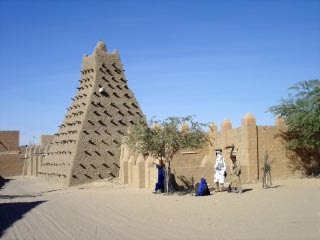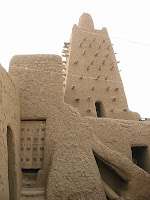Timbuktu is a city in Tombouctou Region, in the West African nation of Mali. It was made prosperous by the tenth mansa of the Mali Empire, Mansa Musa. It is home to Sankore University and other madrasas, and was an intellectual and spiritual capital and centre for the propagation of Islam throughout Africa in the 15th and 16th centuries. Its three great mosques, Djingareyber, Sankore and Sidi Yahya, recall Timbuktu's golden age. Although continuously restored, these monuments are today under threat from desertification.
 Timbuktu is a UNESCO World Heritage Site, listed since 1988. In 1990, it was added to the list of World Heritage Sites in danger due to the threat of desert sands. A program was set up to preserve the site and, in 2005, it was taken off the list of endangered sites. However, new constructions are threatening the ancient mosques, a UNESCO Committee warns.
Timbuktu is a UNESCO World Heritage Site, listed since 1988. In 1990, it was added to the list of World Heritage Sites in danger due to the threat of desert sands. A program was set up to preserve the site and, in 2005, it was taken off the list of endangered sites. However, new constructions are threatening the ancient mosques, a UNESCO Committee warns.Timbuktu is populated by Songhay, Tuareg, Fulani, and Mande people, Timbuktu is about 15 km north of the Niger River. It is also at the intersection of an east west and a north south Trans Saharan trade route across the Sahara to Araouane. It was important historically and still today as an entrepot for rock-salt originally from Taghaza, now from Taoudenni.
Its geographical setting made it a natural meeting point for nearby west African populations and nomadic Berber and Arab peoples from the north. Its long history as a trading outpost that linked west Africa with Berber, Arab, and Jewish traders throughout north Africa, and thereby indirectly with traders from Europe, has given it a fabled status, and in the West it was for long a metaphor for exotic, distant lands: "from here to Timbuktu."
Timbuktu long lasting contribution to Islamic and world civilization is scholarship. Timbuktu is assumed to have had one of the first universities in the world. Local scholars and collectors still boast an impressive collection of ancient Greek texts from that era.By the 14th century, important books were written and copied in Timbuktu, establishing the city as the centre of a significant written tradition in Africa.
Timbuktu was established by the nomadic Tuareg as early as the 10th century. Although Tuaregs founded Timbuktu, it was only as a seasonal settlement. Roaming the desert during the wet months, in summer they stayed near the flood plains of the Inner Niger Delta. Since the terrain directly at the water wasn’t suitable due to mosquitoes, a well was dug a few miles from the river.
Timbuktu is an impoverished town, although its reputation makes it a tourist attraction to the point where it even has an international Timbuktu airport. It is one of the eight regions of Mali, and is home to the regions local governor. It is the sister city to Djenne, also in Mali. The 1998 census listed its population at 31,973, up from 31,962 in the census of 1987.

 Timbuktu was one of the major stops during Henry Louis Gates PBS special "Wonders of the African World". Gates visited with Abdel Kadir Haidara, curator of the Mamma Haidara Library together with Ali Ould Sidi from the Cultural Mission of Mali. It is thanks to Gates that an Andrew Mellon Foundation funding was obtained to finance the construction of the library's facilities, later inspiring the work of the Timbuktu Manuscripts Project. Unfortunately, no practising book artists exist in Timbuktu although cultural memory of book artisans is still alive, catering to the tourist trade. The town is home to an institute dedicated to preserving historic documents from the region, in addition to two small museums and the symbolic Flame of Peace monument commemorating the reconciliation between the Tuareg and the government of Mali.
Timbuktu was one of the major stops during Henry Louis Gates PBS special "Wonders of the African World". Gates visited with Abdel Kadir Haidara, curator of the Mamma Haidara Library together with Ali Ould Sidi from the Cultural Mission of Mali. It is thanks to Gates that an Andrew Mellon Foundation funding was obtained to finance the construction of the library's facilities, later inspiring the work of the Timbuktu Manuscripts Project. Unfortunately, no practising book artists exist in Timbuktu although cultural memory of book artisans is still alive, catering to the tourist trade. The town is home to an institute dedicated to preserving historic documents from the region, in addition to two small museums and the symbolic Flame of Peace monument commemorating the reconciliation between the Tuareg and the government of Mali.Timbuktu's vernacular architecture is marked by mud mosques, which are said to have inspired Antoni Gaudi. These include Djinguereber Mosque, built in 1327 by El Saheli, Sankore Mosque, also known as Sankore University, built in the early fifteenth century and Sidi Yahya mosque, built in the 1441 by Mohamed Naddah. Other attractions include a museum, terraced gardens and a water tower.







No comments:
Post a Comment